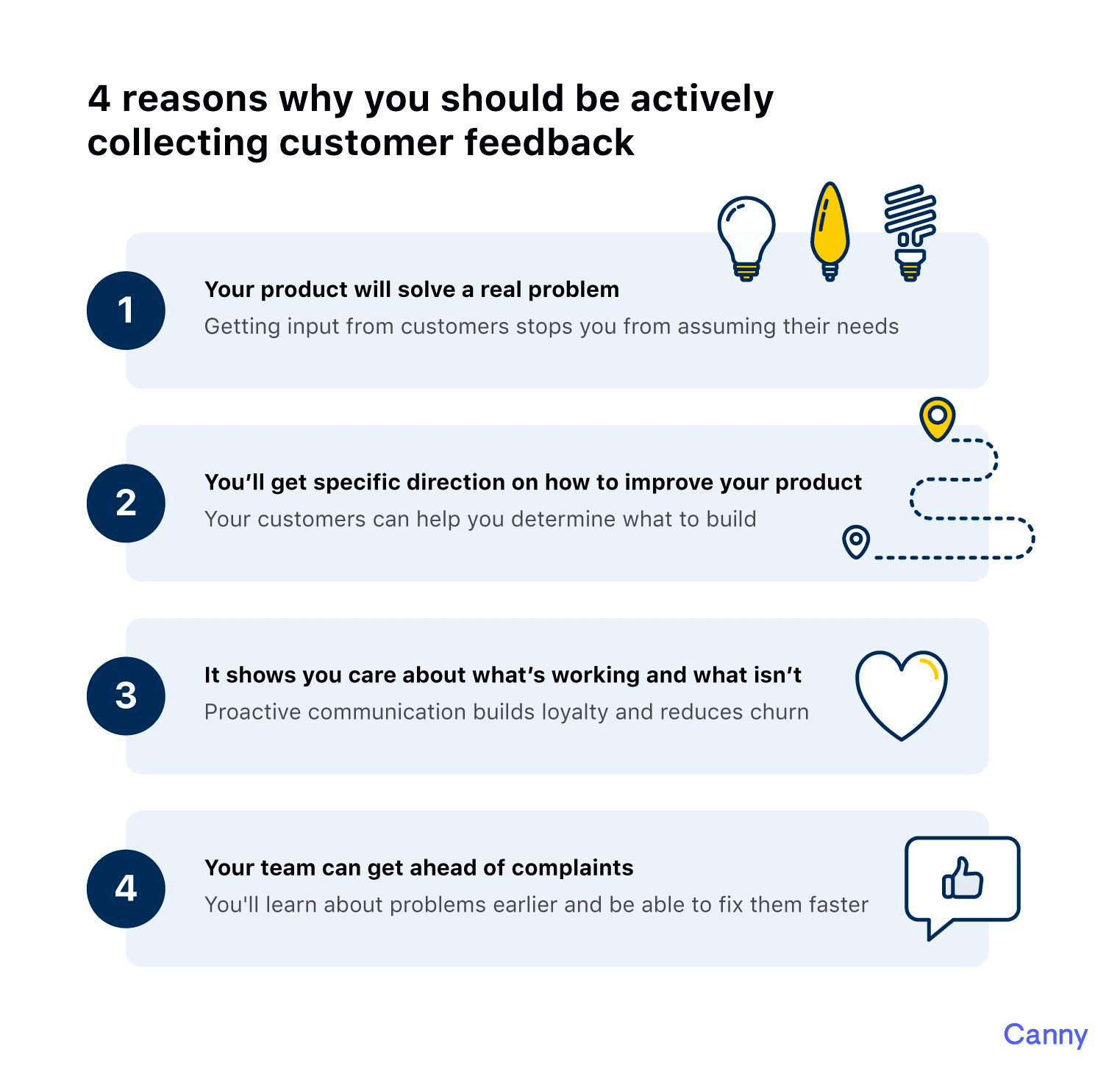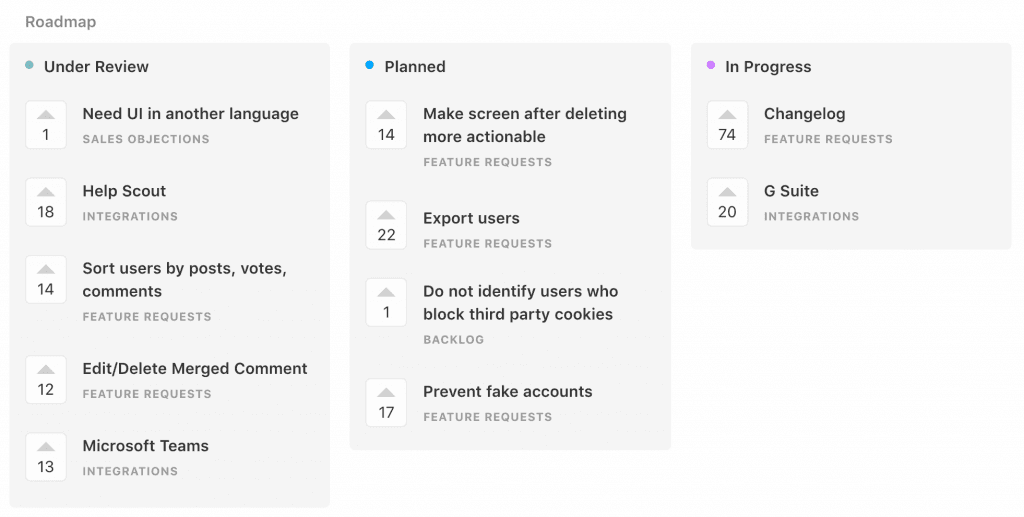4 Reasons Why Marketers Should Care about User Feedback
Want to make your customers feel special and valued? Take the time to collect feedback. It shows that you're dedicated to learning from their experience. This, in turn, can help you create better products and boost customer loyalty. There are many other benefits to collecting and analyzing user feedback. Read on to discover what those are.

Dec 14 2022 ● 8 min read

Why feedback matters
In basic terms, customers want to feel heard. They want to know like their opinion matters and that they’re involved in the process. It’s a great experience – knowing that a brand they trust cares about them and wants to improve. When you openly collect and process feedback, you’re appealing to both the “feeling brain” of your customers (the one that wants to feel heard) and the “thinking brain” too (the one that wants to suggest rational improvements).
Loyalty and trust
The key to brand loyalty and customer retention? Making them feel seen. A recent study revealed that:
- 57% of customers stop doing business with a company if their feedback isn’t addressed
- 67% of customers churned because of a bad experience
- 11% of churn can be prevented through simple outreach
What can do you about that churn? Listen and communicate proactively. You’ll need to go out of your way to hear from your customers. Don’t simply wait and expect them to come to you. Actively seek out feedback instead.
Customers will see that you care and will want to stick around. Even if things aren’t perfect. And, let’s be honest, things are never perfect. In addition, while collecting feedback does help, however, you also need to reward your customers for sharing their views with you. For this, many organizations send gifts such as discount coupons, Best Canvas Prints, Gift Vouchers, and more to thank their customers. You can also use this approach to enhance customer loyalty and trust further!

Product direction
“What should we build next?”, is the ultimate product management question. Among a litany of other things, product managers typically spend a big chunk of their time figuring this out. There are many ways of deciding that (and we’ll discuss them below). One of the best ways is, of course, building what customers actually want. And how can you find out what that is? By asking them.
Yes, collecting feedback requires work. But, in the long run, it makes your job easier. Making confident decisions is easier when you know what customers want. You’ll take the guesswork out of the process and will know exactly where to focus.
Without feedback, you’re probably doing one of the following:
- Researching competition and filling the gaps based on what they have and you don’t
- Asking your team
- Using your own intuition and product knowledge
All of these are great and valuable. But not as valuable as direct customer feedback. This means getting direct quotes from your users.
Of course, that feedback might not align with your goals. No problem! You don’t have to build every single thing that your users request. Saying “no” to those requests is an intricate thing, but it can be done right.
The main idea about feedback is that it gives you direction. Where you take it afterward – that’s up to you.
Gap detection
Imagine you go to a museum to see a painting gallery. You can come very close to each painting and examine the brush strokes in detail. But you’ll only see the full composition when you take a few steps back. Suddenly, individual brush strokes will combine into a cohesive painting. You’ll see the big picture, literally.
Same with your products. When you come too close, you get too attached. It gets harder and harder to see the full picture and identify what you’re missing.
That is, once again, where feedback can help. Your users are also close to your product, but in a different way. They actually use it every day and are the best source of information when it comes to improvement ideas.
Customers' needs change over time, so you'll need to collect product feedback on a regular basis to keep up with them. It can improve your user experience by incorporating changes and updates that align with your customer's needs and expectations.
At the end of the day, when something’s wrong, you’re going to hear about it. Your customers will find a way to give you feedback when they really want to. They’ll email you, tweet at you and even leave Google reviews. Ouch! You don’t want to find out about the gaps in your product that way, do you?
That’s why having a centralized way to gather, analyze and prioritize feedback is so vital.
“Collecting feedback ensures that you have a pulse on what your customers want. From there, you can identify the most impactful things to work on. Keep doing that, and your team will build the best product you can,” – says Sarah Hum, co-founder at Canny.
Bonus: don’t forget to check your competitors’ reviews too! You can find out what they’re missing and capitalize on that as well.
Complaint minimization
When your customers are engaged with you via an easy and direct communication platform, they won’t resort to leaving bad reviews right away. Usually, when something’s not working, users will first try to fix it themselves. If they can’t, they’ll try reaching out to support. If that fails, they might try messaging you on various channels. And only after they’ve been ignored throughout all of this, they will get mad enough to leave a bad review. So really, you can prevent this.
When you go the extra mile to gather user feedback:
- Customers can contact you directly if they have issues
- It’s less likely that they will voice their unhappiness in public
- If multiple customers are experiencing the same problem, you'll know right away
- A public roadmap can also demonstrate that you're working on the problem

This is not to say that you’ll avoid all negative reviews. Remember: you can’t please everyone all the time. After all, “you can be the sweetest peach on a tree, but there will always be someone who simply doesn’t like peaches.”
But, when you collect customer feedback, you can perform some preemptive "reputation management." You will gain a better understanding of your customers that way too.
How it will help you market
Aside from customer satisfaction, feedback can help you be a better marketer. That’s right – all of that feedback is data. It can also be repurposed as user-generated content. And sales teams can also benefit from frequently asked questions, concerns, and complaints. It’s a win-win all around!

Brand boost
What’s a brand? Many people believe that “it’s what people say about you, your product or service when you leave the room.” Handling feedback is directly related to that notion. Even if your product isn’t perfect, you go out of your way to improve customer experience, and ultimately you’re winning. Because your customers will appreciate this attention and your willingness to help. And that, in turn, will only add to your brand.
More data
There are many ways to collect user feedback:
- Surveys
- Interviews
- Contact forms
- Usability tests
- Social media
- Chatbots
- Emails
- Feedback dashboards
When you find the right combination of these methods and ways of processing all this data, it’ll become invaluable. You’ll no longer have to guess which marketing efforts are working, which features are valuable, what you should build next, and what’s lacking. You can also use this data to make conclusions about your success and predictions about the future. Incorporating tools like an AI chatbot into your feedback collection process can enhance the experience by providing real-time insights and streamlining responses.
More content
After you’ve gathered and analyzed all this data, it’s time to start using it to your advantage. There are so many different outlets for it: your website, social media, and email just to name a few. Here are some ideas.
1. Website
63% of consumers are more likely to buy from a website that features customer reviews. Sharing those reviews immediately establishes trust. After all, word-of-mouth is still one of the strongest forms of marketing. People tend to trust other people. So use someone else’s voice to talk about your product.
2. Social media
Establish social proof with the help of user reviews. The majority of social platforms now offer a way for customers to leave a review. So encourage that! After all, if they’ve submitted feedback somewhere already, it’s easy for them to just copy-paste it to a different platform. But they probably won’t do it unless you ask. So make it easy for them, explain how important it is, and they’ll be happy to do it! Bonus: their friends on social media might see those reviews and get curious too. And that’s how you get new eyeballs on your business!
3. Email
Let’s say you want to announce a new feature. So you prepare an email blast and get ready to send it. Emails like these typically have a pretty low open and clickthrough rate. Why? Because people rarely care or have time to read about your new features. Unless…they’ve been waiting for it.
Imagine a scenario where a user submitted a feature request. Then your team talked to them about it, found out more about the request, then added it to the roadmap and actually built it. And the customer has been involved all along, was following the process, and now will get to see this feature come alive. Do you think they’ll open this email? And want to read and learn more?
Not only that, but they’ll probably want to be the first ones to see it, test it, and tell their friends about it! Congratulations – you’ve just created a brand ambassador for your business! All of that is the power of customer feedback.

4. Advertising
Once you’ve got some great reviews, let them speak on your behalf. It’s great to make bold claims about your product. But it’s even better to support it with social proof. Using testimonials, user comments, and results in your ads is extremely effective.
If you got a review from a well-known brand – even better! Those positive brand associations will boost your business in the eyes of potential customers that haven’t heard of you yet.
Happier customers
Listening to your customers can transform every aspect of your company for the better. Start with one clear, simple way to collect customer feedback before expanding into more complex tactics like usability testing and analytics. Try customer support solutions for example. Your support team will bring greater value to your business if they use every interaction as an opportunity to collect quantitative and qualitative feedback.
Feedback – direct access to customers
Here’s the truth: your customers are already talking about you. They’re discussing the good, the bad, and the ugly with their co-workers, managers, and maybe even friends and communities. It’s only a matter of time before that conversation becomes public knowledge. So it’s time to take charge and direct that conversation.
There’s no better way of building relationships with your customers than inviting them to have a conversation. And there’s no better way to win their trust than taking their opinion to heart.
When users see how much you truly care, how much their voice matters, and how their ideas can actually come alive, they’ll trust you that much more. They’ll want to stick around, they’ll cheer you on, and they’ll talk about you when you don’t even ask them. So reap the benefits of user feedback and start pleasing your customers today!
Author: Maria Vasserman
Maria loves all things creative – writing, photography, movies, and beyond When she's not creating content to tell the world about Canny, she's either photographing a wedding, jumping at a rock concert, camping, traveling, snowboarding, or walking her dog
Published on Dec 14 2022

WRITTEN BY
Mile ZivkovicMile is the ex-Head of Content at Whatagraph. A marketing heavy with almost a decade of SaaS industry experience, Mile has managed multiple content marketing teams without losing an ounce of his writing passion.